
Gods, Graves & Sapphires*
An editorial by William F. Larson, President, Pala International
Fifty years ago I developed what has become a lifelong fascination with mineral specimens. I was enthralled by these small marvels of nature and have collected them ever since, including gemstones – minerals fashioned by man. What first began as physical attraction later developed into a deep sense of appreciation of the natural beauty of these rare, durable objects found in our planet Earth. But recent events in the field of gems have left me with a deep sense of foreboding.
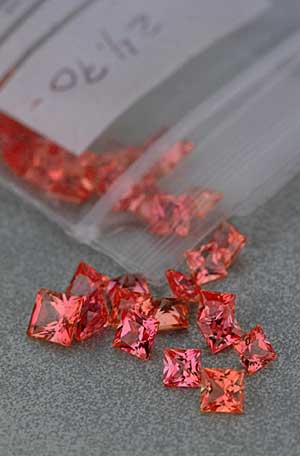 |
| Strange fruit. Beryllium-diffused orange sapphires purchased in Bangkok by the author in Dec., 2001. Photo: Robert Weldon |
Strange fruit
In late 2001, on a buying trip in Bangkok, I purchased a
number of extremely beautiful orange sapphires. The color
of many fell into the padparadscha region, that sunset drenched
lotus land that constitutes the most coveted of all fancy
sapphires.
From the quantity of stones on
offer, only the optically challenged could miss that a new
treatment process had been discovered, but with reassurance
from the sellers that only heat was involved, I happily
bought up a handful of these odd oranges.
Back home, I learned these were
strange fruit indeed. The AGTA
lab’s Ken Scarratt had also obtained samples of
these citrus sapphires and discovered disturbing orange
color rims surrounding pink cores.
Encroaching on
nature
Conversations over the next several weeks culminated in
the revelation by the GIA’s
Shane McClure at the 2002 Tucson show that unnatural
amounts of beryllium had been found in the yellow-orange
layers. In other words, the stones were being artificially
colored by the addition of beryllium (Be).
Doubtless this treatment was discovered
when a piece of chrysoberyl was accidentally heated with
some sapphires. But when masses of these once-rare colors
appeared in the market (one Japanese lab reportedly certified
over 20,000 alone), we should have suspected that this was
not just our parents’ home cooking. Meanwhile, beryllium
treated yellow sapphires appeared, then rubies and still
later, blues.
By mid-2002, thanks to the work
of John Emmett, George Rossman, Ken Scarratt, the GIA and
others, we understood the coloring mechanism. But identification
was altogether another matter. Not all Be-treated stones
showed obvious color rims. In many cases, particularly in
the yellows, the beryllium penetrated completely through
the gem, making it undetectable with ordinary gemological
equipment.
At a certain point, the coin rolled
into the abyss. I realized that, as good a gemologist/ mineralogist
as I am – I could not tell when a stone had been berylliumized.
Indeed, today most stones require sophisticated analysis
at over $400 per sample, and it is unlikely the cost of
testing will fall quickly.
This revelation shakes me to my
core because, as a mineralogist I know that while gem-quality
ruby and sapphire is scarce, ordinary corundum that might
be treated into gem-quality ruby and sapphire is decidedly
less so. Indeed, tons of treatable material are potentially
available from multiple localities.
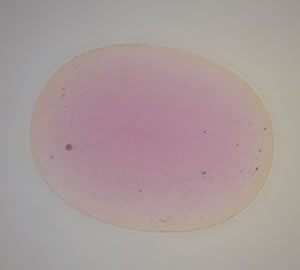 |
| Orange rim surrounding a pink core in a beryllium-treated orange sapphire from Madagascar. The color rim is visible when the gem is immersed in di-iodomethane and is evidence of a treatment applied after cutting. Note that recutting such stones will produce a loss of the orange color. Photo: R.W. Hughes |
Unnatural acts
Discussions with my friends John Emmett and George Rossman
have crystallized this for me. According to these experts,
there is probably no sapphire that is naturally heated in
the ground over approximately 1400° Celsius. Fine natural
sapphires and rubies are subjected to far lower temperatures
in the ground than that produced via modern heat treatment.
Simply, when world authorities
tell me that unnatural acts happen to corundum at temperatures
beyond 1600° Celsius, I can clearly read the writing
on the furnace wall.
On the edge
In the past three decades, heat treatment has increased
the availability of gem-quality corundum perhaps a hundred
fold. But with today’s beryllium treatments and those
face-lifts not yet discovered we teeter on the precipice
of what might be a 100,000-fold amplification of supply.
Can our industry withstand this?
There will be those who argue
that the increase in supply only serves to sate ever-increasing
demand. But such notions cannot withstand even cursory scrutiny.
The
chart below was compiled from The Guide’s price
sheets. It tracks sapphire prices for 3–4 ct. stones
for the years 1984–2003. Note that sapphire prices
are actually lower today than they were some 20 years
ago, even though the demand for sapphires has increased
along with the world’s population.
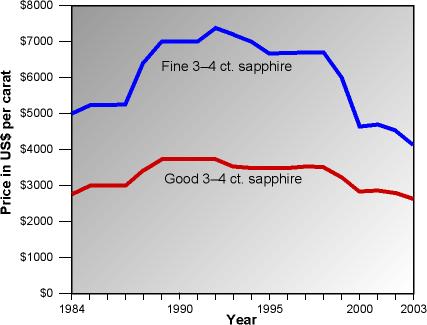 |
| Graph tracking the price of 3–4 ct. sapphires over the past 20 years. The Good category corresponds to levels 5 and 6 in The Guide, while Fine represents levels 7 and 8. Price data courtesy of Stuart Robertson of The Guide. |
What could
account for such flat prices? It’s certainly not increased
production. The only answer that makes any sense is treatments.
Treatments make it possible to use more and more of existing
production, thus keeping sapphire prices artificially low.
It is not low prices that bother
me, but the fact that treated stones raise expectations
to unreasonable levels. The sublime beauty of nature is
lost.
We already see this today in the
ruby market – to the degree that treated stones often
make it difficult to sell the natural product. Treated rubies
from Möng Hsu in Burma have so snookered the senses
of the buying public that many no longer recognize the true
face of nature. A gorgeous natural creation like the Matterhorn
is now reduced to the equivalent of a ride at Disneyland.
The blue topazization
of sapphire
We have now come to this point: my company will not buy
gemstones that are potentially beryllium treated. From now
on, we will only purchase stones we can be sure have not
been treated in a radical way. If testing is too expensive,
we will be forced to carry only natural stones, or those
heated at low temperatures.
Why? Because corundum is not a
rare mineral. It is only rare in gem quality. If treatments
can take quantities of non-gem material and turn it into
gems, then there will be no more value.
I remember when blue topaz cost
$50/ct., then $40/ct., going down to $10/ct., and now what
is it… $2/ct.? Like corundum, ordinary topaz was never
rare. But naturally occurring blue topaz was quite scarce.
The moment man figured out how to turn the ordinary into
the extraordinary – with no easy way to separate the
two – the price plummeted.
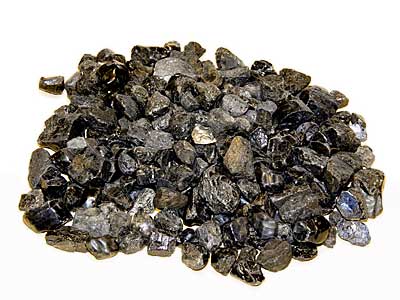 |
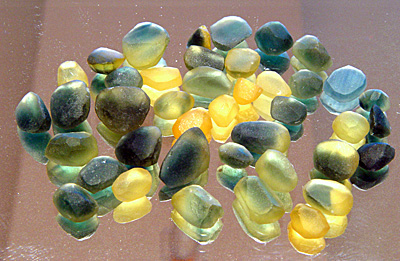 |
| Top: Rough industrial
grade sapphire from Africa prior to beryllium
diffusion. Bottom: The same sapphire after beryllium diffusion and then preforming. Tons of such material exists. (Images courtesy of John Emmett) |
Beryllium poisoning
Now that we have the extraordinary ability to color corundum
(a treatment that involves far less sophistication than
production of blue topaz), what should be the price for
corundum artificially colored by man? What is the difference
between artificially colored corundum and a synthetic ruby
or sapphire made out of re-crystallizing naturally occurring
grains of corundum? These are important questions. Some
might dismiss them as philosophical minutiae unworthy of
attention. I would say they are fundamental to the existence
of our trade, which stretches across millennia of human
history. Our trade is a link with the past, both human and
geologic, and in that sense, it transcends eras, transcends
fads, goes to the root of who we are and where we have come
from.
Gems whose supply is subject to
human ingenuity rather than Mother Nature are common. Therefore,
such stones have only the value humans are willing to put
on them. Yes, all gems are fashioned by man, but what happens
when man’s handiwork extends not just to smoothing
out surface imperfections with grit and grinding wheel,
but also literally to redecorating the atomic grid? This
is where man tries to become god. And where nature –
poisoned – falls into the grave.
As I said before, not only do I
buy and sell gems, but I also collect. These rare natural
creations are my passion, among the greatest loves of my
life. With the gems I buy, sell and collect, I want those
formed by nature. I want no part of playing god or executioner.
I’ll leave that to the creator.
Footnote
* With apologies to C.W. Ceram, author of Gods,
Graves & Scholars
Further reading
- Orange-pink sapphire alert by the AGTA GTC, posted 8 Jan., 2002
- The Skin Game – by Richard Hughes, covers the earliest developments on beryllium treated orange sapphires in a comprehensive article. Fully illustrated. Posted Feb. 2002.
- From Gems & Gemology: GIA researchers uncover important data on new treated corundum by the GIA, posted 15 Feb., 2002
- Understanding the new treated pink-orange sapphires by John Emmett and Troy Douthit, posted 13 May, 2002
- Beryllium diffusion of ruby and sapphire by John L. Emmett, Kenneth Scarratt, Shane F. McClure, Thomas Moses, Troy R. Douthit, Richard Hughes, Steven Novak, James E. Shigley, Wuyi Wang, Owen Bordelon and Robert E. Kane, Gems & Gemology, Summer 2003, pp. 84–135.
Acknowledgements
The author would like to thank Stuart Robertson of The
Guide for supplying the price data on sapphire and John
Emmett for the photos of beryllium-treated blue sapphires.
Thanks also to John Emmett, George Rossman, Ken Scarratt,
Shane McClure and James Shigley for enriching conversations
on corundum. Title photo © R.W. Hughes.